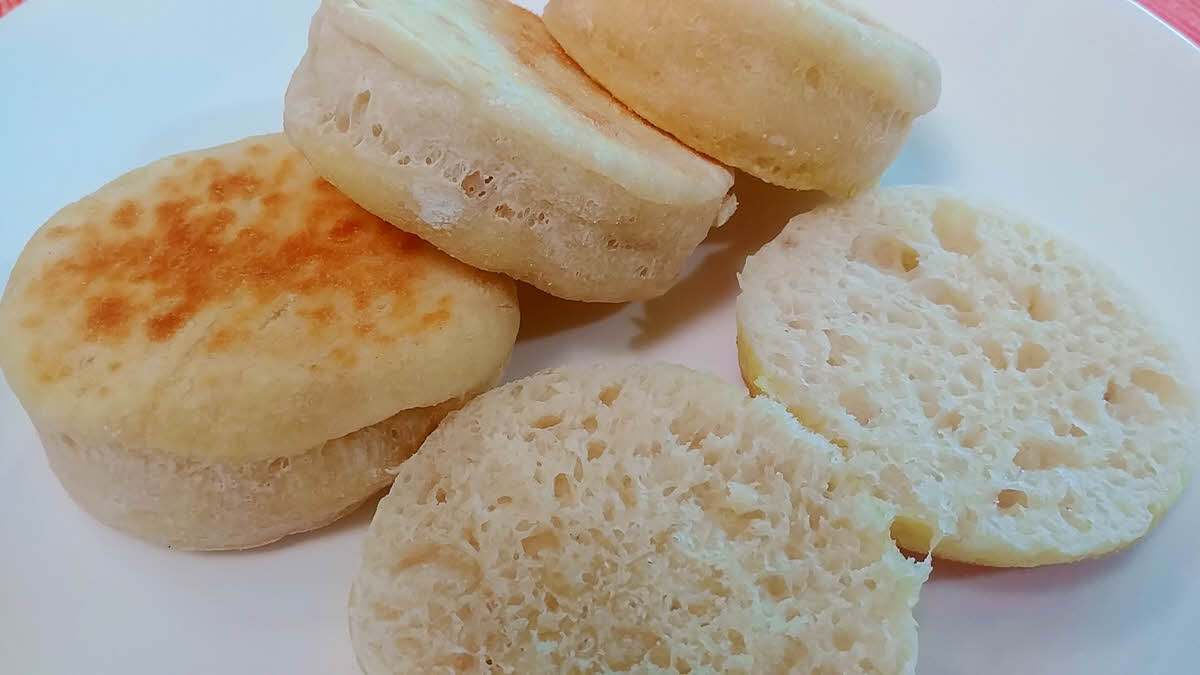This English Muffin recipe has been taken from the Tartine Bread book by the owner of the famous Tartine Bakery in San Francisco. If you are looking to learn how to make sourdough breads, then this is the best book ever. Here is the link to buy it from Amazon:
English Muffin is a griddle cake with a tender, open-textured crumb, perfect for pooling melting butter and home made jam. English Muffins are great toasted and could be made a day or two ahead but there is nothing quite like an English Muffin fresh off the griddle.
| Preparation Time: | 20 hours |
| Servings: | 12 English Muffins |
| Difficulty: | Medium |
Ingredients for poolish
| All purpose flour | 100 gm |
| Water at 75 degrees F | 100 gm |
| Active dry yeast | 1.5 gm |
Ingredients for leaven
| Mature starter | 1 tbsp |
| All purpose flour | 110 gm |
| Water at 80 degrees F | 110 gm |
Ingredients for English Muffin
| Leaven | 200 gm |
| Poolish | 200 gm |
| Water at 75 degrees F | 250 gm |
| All purpose flour | 325 gm |
| Bread flour | 175 gm |
| Salt | 12 gm |
| Rice flour + whole wheat flour | For dusting |
| Clarified Butter or Ghee | 4 tbsp |
Method
- To make poolish, in a bowl mix poolish ingredients and let it rest for 3 to 4 hours at about 75 to 80 degrees F or overnight in refrigerator.
- To make the leaven, mix all the leaven ingredients thoroughly so that no dry flour remains. Let is rest for 3 to 4 hours at about 80 degrees F.
- When both poolish and leaven pass the float test (drop a spoonful of batter in water, if it floats, it is ready) they are both ready otherwise wait for more time.
- To prepare the baguette dough, mix 200 gm leaven and 200 gm poolish in 250 gm warm water. Whisk it thoroughly so that they mix up properly.
- Now add both the flours and mix it with your hand so that no dry flour remains.
- Cover and rest for 40 minutes. Don’t skip this step. This is to autolyse the dough. While resting, glutens swell and form chains that become the gas trapping structure of the dough. Autolyse improves the effectiveness of the time spent mixing while shortening the time needed to actively develop the dough.
- After the resting period, fold the dough and transfer in a bowl that is a poor conductor to maintain the warm temperature. Dough will now begin to rise. This is called bulk fermentation. The primary purpose of this step is to develop the flavor and the strength in the dough. This step is highly temperature sensitive. The dough should be kept at temperature between 78 to 82 F to accomplish full bulk rise in 2.5 to 3 hours.
- To fold, dip your hand in water to prevent sticking and grab the underside of the dough, stretch it up and fold it back over the rest of the dough. Turn the bowl 90 degrees and repeat the fold. Do this total 4 times.
- After the first fold, mix the salt in 10 gm of warm water and add to the dough. Incorporate both in dough by squeezing the dough between your fingers.
- For the next 3 hours, fold the dough 4 times every 30 minutes.
- The dough development that bakers usually achieve by kneading is accomplished here by folding the dough with much less work.
- By the end of 3 hours, the dough will feel aerated and softer. A well developed dough is more cohesive and releases from the sides of the bowl when you do the turns. You will see 50% increase in volume. More air bubbles will form along the sides of the container. Now the dough is ready to be shaped.
- Flour the work space lighly and bring out the dough. Gently push the sides under using the bench knife or pastry scraper and make a round dough using as little flour as possible and a good surface tension. Repeat with each portion.
- Leave the dough to rest on the work surface for about 30 minutes. This stage is called bench rest. Cover the dough so that it does not dry up. The dough will spread like a pancake.
- Turn the dough onto a well floured kitchen towel and let it relax for 10 minutes. Dust the top with rice flour and press the dough from the middle to make a rectangular shape of 1 inch or less thickness. Make sure that the dough is evenly spread. Cover with a kitchen cloth and refrigerate overnight to complete the final rise.
- Remove the dough from the refrigerator about 30 minutes before cooking the muffins.
- Heat a skillet over medium low heat. Spread a little clarified butter.
- Using a cookie cutter, cut the muffins from the dough and place them on the skillet.
- After 2 minutes, dough will rise about an inch. When you think the underside is golden brown, flip it over. Add more butter if required. Cook for another 2-3 minutes. The top and bottom should be golden brown and crisp and the edges light and soft.
- Remove the muffins from the skillet and serve them warm or let cool on a rack. Wipe the skillet clean and repeat with other muffins. English Muffins are ready.
- English Muffins freeze well in a freezer proof container. Thaw at room temperature for 2 hours and toast to restore.
Summary

Recipe Name
English Muffin
Author Name
Ruchi Garg
Published On
Total Time
Average Rating




 Based on 5 Review(s)
Based on 5 Review(s)


















